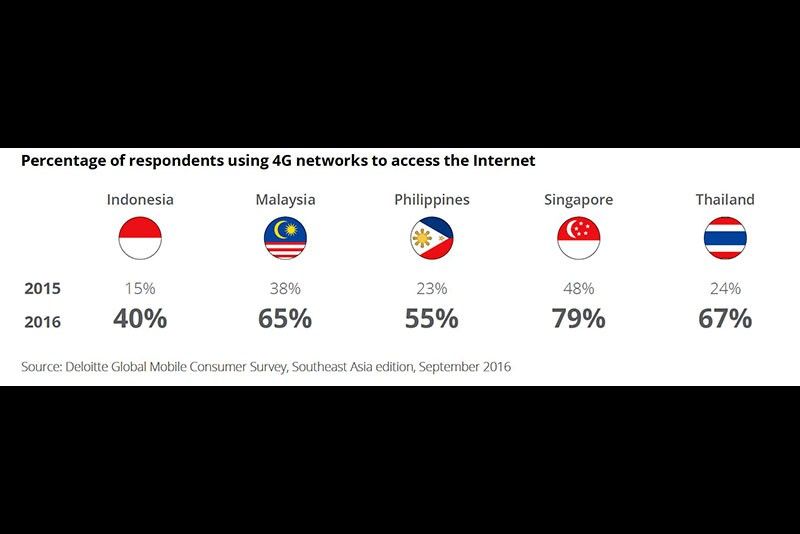Majority of Filipinos now on 4G – survey

MANILA, Philippines – More than half or 55 percent of Filipino mobile consumers now use 4G Long-Term Evolution (LTE) networks to access the internet, up from only 23 percent a year ago, according to a survey from audit, consulting and tax advisory services firm Deloitte.
The survey, which was released by Deloitte Southeast Asia local member firm Navarro Amper & Co., covered five countries – Indonesia, Malaysia, the Philippines, Singapore, and Thailand – and asked 5,000 consumers (1,000 per country) aged 16-44 about their use of mobile devices and consumption of services.
The increase in the percentage of Filipinos using 4G LTE is in line with the growth seen in other Southeast Asian countries covered by the survey. The increase in 4G users in the Philippines also indicated that local telco operators’ investments to modernize and expand network coverage particularly for LTE are paying off.
PLDT Inc. and Globe Telecom Inc. activated last year their LTE cell sites using the 700 MHz band they acquired from San Miguel Corp. The 700 MHz band previously held by SMC can penetrate buildings and provide greater indoor coverage.
“These are positive signs that the local telco companies are being responsive to what Filipino consumers have been demanding for quite some time now: better, faster data networks,” said Greg Navarro, managing partner and CEO of Navarro Amper & Co.
Ramon Isberto, head of public affairs at PLDT and Smart Communications Inc. welcomed the result of the survey saying it clearly underscored the efforts of telcos to roll out 4G facilities to improve LTE coverage in the country.
“As you know, expanding LTE coverage is the linchpin of Smart’s ongoing three-year network program which is now focused in Metro Manila and Metro Cebu after we finished Metro Davao. We will bring this to the rest of the country as well. LTE is a key factor in improving mobile internet in the country,” Isberto said.
For her part, Yoly Crisanto, Globe senior vice president for corporate affairs said the favorable survey result is a function of the aggressive network upgrades on LTE.
“For Globe in fact, we are near 100 percent availability of 4G/LTE in NCR (National Capital Region) alone. The same expansion is being done in key cities across the regions,” Crisanto said.
With the exception of Indonesia, Southeast Asia showed a significant overall increase in adoption of 4G LTE networks. The gulf between 3G and 4G adoption in Indonesia has been widely attributed to the slow launch of LTE, as only key broadband cities have access to limited 4G services. Thailand, on the other hand, witnessed a significant increase in the shift toward 4G, as a result of its recent aggressive nationwide deployment and successful LTE auction.
In terms of internet consumption on mobile phones, the majority of respondents in Indonesia, Malaysia and Thailand use their mobile phones at home, at work or at their place of study. Singapore respondents, however, used them mostly in public spaces and while commuting. When connected to the 4G LTE network, Southeast Asia users spend most of their time on social networking activities, online games and video streaming.
Southeast Asia respondents who have started using 4G LTE networks also tend to spend more time on their mobile phones watching videos, playing online games and participating in social media activities. The shift to 4G LTE, however, did not change the amount of time they spent on voice calls and video calling.
In the Philippines, the most popular applications are those for social networking, messaging, and gaming, the study said.
The use of Voice over Internet Protocol (VoIP) has also increased across all Southeast Asian countries, with Thailand showing the biggest improvement – from 33 percent to 41 percent. In the Philippines, 33 percent of respondents use VoIP, compared to 29 percent in 2015.
“By differentiating their service offerings and thinking holistically about their customer experience and delivery of services, telcos can take advantage of this growing shift toward VoIP, which we’re seeing here among individual consumers and even with businesses,” Navarro said.
In terms of smartphone brands, Samsung was the leader in the Philippine market with 34 percent of respondents saying they own a Samsung smartphone compared to 23 percent who said they owned an iPhone. In 2015, only 18 percent of Filipino respondents said they own a Samsung phone, while nearly half or 47 percent owned an iPhone
Samsung also dominated the other Southeast Asian countries except in Singapore where Apple took the top spot.
Although “browsing shopping websites and applications” was ranked as the most common purchasing activity among respondents, mobile payments are still not widely used in the region. It is typically used to pay for taxi services such as Uber or Grab and even then, only 13 percent of Filipinos do so.
Overall adoption of mobile Internet of Things (IoT) applications also remains low in the region compared to other developed markets: while 50 percent of Filipino respondents said they have used mobile IoT applications at least once, only 21 percent own or have access to a Smart TV, which emerged as the most popular connected entertainment device in the Philippines.
According to the survey, the reasons for choosing a mobile operator differ across the Southeast Asia markets, depending on the stage? of maturity in terms of network deployment.
Across the board, however, respondents prioritized choosing an operator that their family and friends also use. But even respondents who are satisfied with their connection may be enticed to change operators for more favorable internet package plans or better quality internet connection.
Indonesia and Philippines respondents also emerged as the top multi-SIM users, with 71 percent and 60 percent using these services respectively. This is in contrast to Singapore, where the majority of respondents prefer to have only one SIM.
- Latest
























